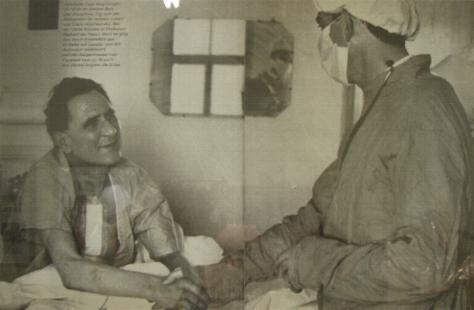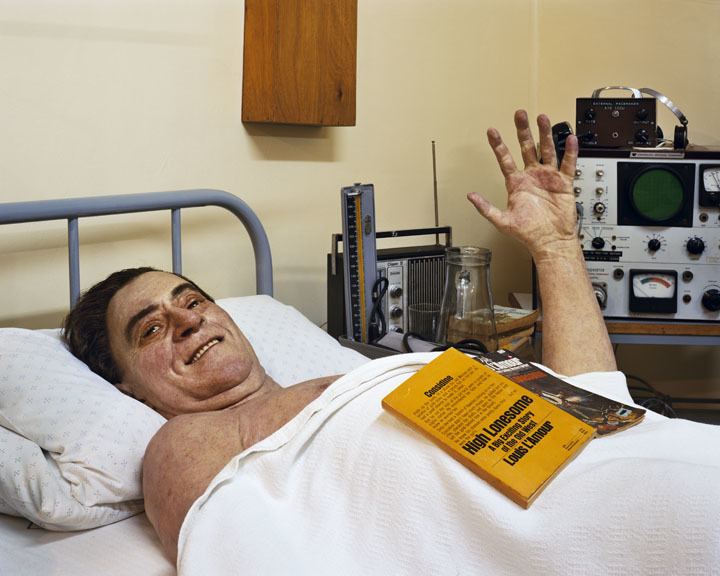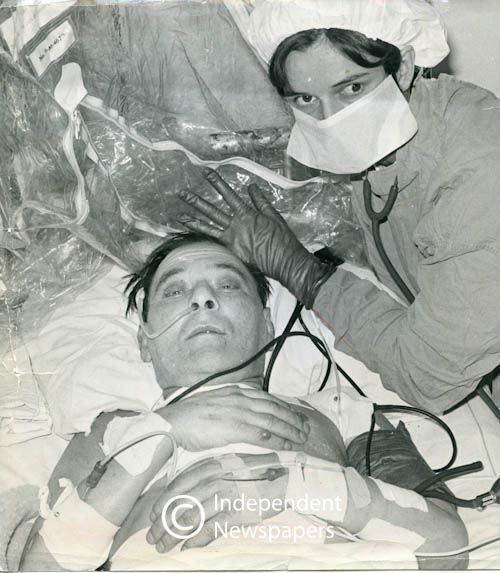Name Louis Washkansky | ||
Died December 21, 1967, Cape Town, South Africa Similar Denise Darvall, Christiaan Barnard, Philip Blaiberg | ||
SYND 8 12 67 MRS WASHKANSKY INTERVIEW
Louis Washkansky (1913 – 21 December 1967) was a South African man who was the recipient of the world's first human-to-human heart transplant, and the first patient to regain consciousness following the operation. Mr. Washkansky lived for 18 days and was able to speak with his wife and reporters.
Contents
- SYND 8 12 67 MRS WASHKANSKY INTERVIEW
- Louis Washkansky Human Heart and Cardiology
- Biography
- Medical background
- Potential transplant in Nov 1967 which did not work out
- Operation and outcome
- References
Washkansky was actually the second human recipient of a heart transplant overall, in that Dr. James Hardy had done a transplant in 1964 in which Boyd Rush received a chimpanzee's heart, although the patient in that case only survived an hour and did not regain consciousness.

Louis Washkansky - Human Heart and Cardiology ❤️❤️❤️
Biography

Washkansky was a Lithuanian Jew who migrated with his friends from Slabodka to South Africa in 1922, aged nine, and became a grocer in Cape Town. Washkansky saw active service in World War II in East and North Africa and Italy.

He was an avid sportsman. He took part in football, swimming, and weightlifting.
Medical background

However, late in his life his health declined substantially: he was diabetic, and had an incurable heart disease, causing him to suffer three heart attacks. The last of these heart attacks led to congestive heart failure.

In April 1966, Washkansky visited Groote Schuur Hospital due to his pre-existing illness. He was first seen by Dr. Barry Kaplan, who in July 1966 had asked if Dr. Christiaan Barnard would be willing to attend Washkansky. Barnard had performed a number of laboratory tests and an in-depth examination on Washkansky and came to the conclusion that nothing could be done to help him. In January 1967, Washkansky was referred to Dr. Mervyn Gotsman, a cardiologist at the Cardiac Clinic in Groote Schuur Hospital due to refractory heart failure. Washkansky underwent cardiac catheterisation, confirming severe heart failure and was subsequently referred to Barnard for possible surgery.

Washkansky was re-admitted to Groote Schuur on Sept. 14, 1967, which was also the Jewish New Year. As a result of heart attacks in 1965, approximately only one third of his heart was still functioning. In late October, he went into a diabetic coma, but regained consciousness. Once when he was swollen with fluid and in considerable pain, his wife Ann asked him in a whisper how he was doing. He managed a smile and whispered, "I'm on top of the world." He was also suffering from kidney and liver failure. On November 10, Val Schrire put forward Washkansky as a possible heart transplant candidate.

When Barnard met with Washkansky, the patient put down a western novel which showed a cowboy holding a smoking gun. Barnard explained the possibility of a transplant and Washkansky was agreeable to the possibility. As Barnard turned to go, he saw Washkansky again pick up his western novel. Barnard decided that someone seriously ill was likely to live for the here and now. Afterwards, Ann found her husband Louis to be "oddly buoyant." When Barnard later explained the possibility of a transplant to both of them, the idea was so new that Ann initially worried her husband might absorb some of the personality of the donor heart.
Barnard stated to Ann and Louis Washkansky that the proposed transplant had an 80% chance of success, which has been criticised as "misleading".
Part of the pre-op procedure was to take swabs from Washkansky's skin, nose, mouth, throat, and rectum to find out what bacteria lived on and in his body, so that the most effective antibiotics could be given after the transplant. He was also frequently washed down with Phisohex.
Potential transplant in Nov. 1967 which did not work out
In late Nov. 1967, a potential donor was identified. A young black man had fallen off a truck and suffered a catastrophic head injury. Although the Chief of Cardiology, Val Schrire, had previously expressed a strong preference to avoid a 'colored' donor, police approached the young man's family for permission for him to be a heart donor. McRae writes that the family was "in shock after they were confronted by a policeman." The EKG of the donor heart, however, showed depressed ST segments, and gave the reluctant Val Schrire a medical reason not to continue with the transplant of a 'colored' donor heart in apartheid South Africa. Washkansky, who had been cleaned and shaved for the possible attempt, felt let down and disappointed when it didn't go forward. He felt his future chances were slim.
Operation and outcome
He received his heart transplant on 3 December 1967, at the Groote Schuur Hospital in Cape Town, South Africa.
The operation lasted approximately six hours beginning at 1 a.m. with Christiaan Barnard leading a team of thirty surgeons, anaesthetists, nurses, and technicians. His brother Dr. Marius Barnard assisted with the surgery.
25-year-old Denise Darvall and her mother had been struck by a drunk driver while crossing a busy street on a Saturday afternoon. Her mother died at the scene. Denise was taken to Groote Schuur. Peter Rose-Innis, the hospital's senior neurosurgeon, attended to her. A skull X-ray showed two serious fractures. She showed no sign of pain when ice water was poured in her ear. In addition, her brain had no sign of electrical activity when they ran a scan. A blood transfusion and respirator maintained the beat of her heart. Coert Venter and Bertie Bosman were the doctors who approached Denise's father Edward Darvall and asked for permission to use her heart for a possible transplant. He had been at the scene of the original accident and had been sedated after being brought to the hospital. As he waited, he thought they were still trying to save his daughters life. Bosman and Venter knocked gently and entered the room. Bosman did most of the talking. He asked Edward to please sit on the couch, and then he went on to explain that Denise could never be brought back to even the most remote semblance of consciousness. Her heart continued to beat, but it beat within an empty shell. She had already taken leave of her body. Bosman went on to say that there was a man in the hospital who was desperately ill and in need of a heart transplant, and perhaps Edward could do him a great kindness if they would allow them to transplant his Denise's heart. Bosman and Venter withdrew from the room, saying that he should take as long as needed to consider their request and that they would understand if he declined to give his consent.
In the four minutes Edward Darvall took to reach his decision he thought of his daughter, including a birthday, including a gift she had given to him from a first paycheck. He began to cry and decided what needed to be done. He composed himself and summoned the doctors back to the small room. He told them that if they could not save his daughter, they must try to save this man.
Although Washkansky died of pneumonia eighteen days after the transplant because of a weakened immune system, Barnard regarded the surgery as a success because the heart was "not being stimulated by an electrical machine". As Barnard related in his book, One Life, a decision was made on the fifth postoperative day to bombard Washkansky's system with immunosuppressants to guard against a potential rejection of the new heart. As later heart transplants would reveal, the signs noted at that time were part of a resettling program for the new heart and not necessarily an indication of rejection. Of course, as Washkansky and everyone else understood, the operation had never been done before, was experimental, and they were, in effect, feeling their way in the dark. However, over the ensuing decades, heart transplants became fairly routine procedures.
